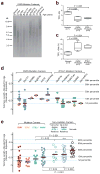Exome sequencing links mutations in PARN and RTEL1 with familial pulmonary fibrosis and telomere shortening
- PMID: 25848748
- PMCID: PMC4414891
- DOI: 10.1038/ng.3278
Exome sequencing links mutations in PARN and RTEL1 with familial pulmonary fibrosis and telomere shortening
Abstract
Idiopathic pulmonary fibrosis (IPF) is an age-related disease featuring progressive lung scarring. To elucidate the molecular basis of IPF, we performed exome sequencing of familial kindreds with pulmonary fibrosis. Gene burden analysis comparing 78 European cases and 2,816 controls implicated PARN, an exoribonuclease with no previous connection to telomere biology or disease, with five new heterozygous damaging mutations in unrelated cases and none in controls (P = 1.3 × 10(-8)); mutations were shared by all affected relatives (odds in favor of linkage = 4,096:1). RTEL1, an established locus for dyskeratosis congenita, harbored significantly more new damaging and missense variants at conserved residues in cases than in controls (P = 1.6 × 10(-6)). PARN and RTEL1 mutation carriers had shortened leukocyte telomere lengths, and we observed epigenetic inheritance of short telomeres in family members. Together, these genes explain ~7% of familial pulmonary fibrosis and strengthen the link between lung fibrosis and telomere dysfunction.
Conflict of interest statement
The authors declare no competing financial interests.
Figures




References
-
- Armanios MY, et al. Telomerase mutations in families with idiopathic pulmonary fibrosis. N Engl J Med. 2007;356:1317–1326. - PubMed
Publication types
MeSH terms
Substances
Associated data
Grants and funding
- UL1 TR001105/TR/NCATS NIH HHS/United States
- P30 ES005605/ES/NIEHS NIH HHS/United States
- K12HD068369/HD/NICHD NIH HHS/United States
- UL1TR001105/TR/NCATS NIH HHS/United States
- T32 GM007205/GM/NIGMS NIH HHS/United States
- P30 DK054759/DK/NIDDK NIH HHS/United States
- K12 HD068369/HD/NICHD NIH HHS/United States
- HHMI/Howard Hughes Medical Institute/United States
- R01 HL093096/HL/NHLBI NIH HHS/United States
- U54HG006504/HG/NHGRI NIH HHS/United States
- U54 HG006504/HG/NHGRI NIH HHS/United States
- R01HL093096/HL/NHLBI NIH HHS/United States
LinkOut - more resources
Full Text Sources
Other Literature Sources
Molecular Biology Databases

